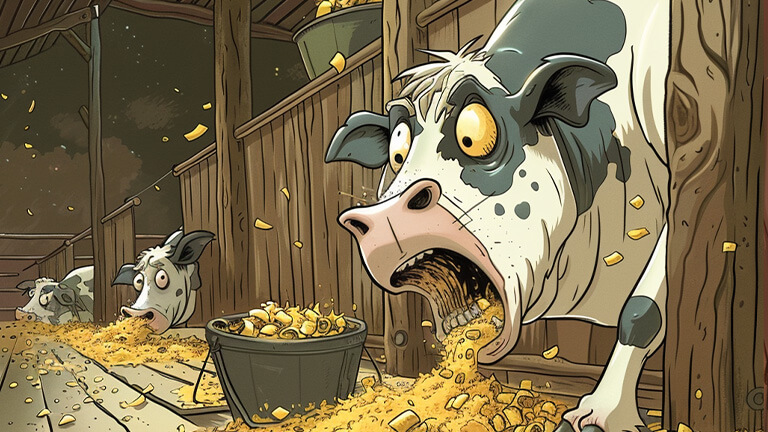Suboptimal (incomplete) diet#

If cattle receive less feed than they need to achieve an optimal diet, the diet is considered suboptimal. This leads to the following consequences:
- The rate of weight gain decreases.
- Manure production is decreasing.
- Milk production decreases.
- The period of preparation for mating increases.
- The period of pregnancy is extended.
To avoid negative consequences, it is important to provide complete, balanced feeding.
Table: Amount of feed required for an optimal diet depending on age group
| Age, days | Types of feed |
|---|---|
| 1–60 | 7 |
| 61+ | 6 |
Calculation of weight gain, milk production, and manure production with a suboptimal diet#
For cattle aged 1–60 days:
\( N = N_о * A / 7 \)For cattle aged 61 days and older:
\( N = N_о * A / 6 \)Variables:
| Variable | Explanation |
|---|---|
| \( Nо \) | parameter value for optimal diet |
| \( A \) | number of feed types actually received |
| \( B \) | the number of feed types required for an optimal diet |
Calculating the timing of pregnancy and preparation for mating with a suboptimal diet#
For cattle aged 1–60 days:
\( N = N_о * 7 / A \)For cattle over 60 days old:
\( N = N_о * 6 / A \)The variables are similar to the previous ones.
Examples#
Situation 1#
On the 60th day, a young bull (1–60 days) received only 5 types of feed out of 7, and 2 types were missing.
- Weight gain with optimal diet: 16 kg → with non-optimal:
- Manure production with optimal diet: 28 kg → with non-optimal:
Situation 2#
An adult cow (241–420 days, weight 350 kg) receives only 3 types of feed out of 6, half of one type → a total of 3.5 types.
Initial parameters with optimal diet: weight gain 0.275 kg, manure production 21 kg, milk 5.5 l, preparation for mating 6 days, gestation 26 days.
- Weight gain:
- Manure production:
- Milk production:
- Preparing for mating:
- Pregnancy:
Situation 3#
An adult cow (61–240 days) was not given any type of feed.
- Weight gain with optimal diet: 1.083 kg → weight loss:
- Products (milk and manure) are not produced.
- The processes of pregnancy and preparation for mating stop for a day.